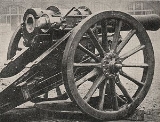
6 inch 30 cwt howitzer
Encyclopedia
The Ordnance BL 6 inch 30cwt howitzer was a British
medium howitzer
used in the Second Boer War
and early in World War I
. The qualifier "30cwt" refers to the weight of the barrel and breech together which weighed 30 hundredweight
(cwt) : 30 x 112 lb = 3360 lb. It can be identified by the slightly flared shape of the muzzle and large recuperator springs below the barrel.
Its original shell was 122 lb 9 oz Lyddite explosive. In 1901 a lighter 100 lb (45.4 kg) shell was introduced which increased maximum range when firing from its wheeled travelling carriage to 7000 yards. These were then referred to as the "heavy" and "light" shell respectively. A 100 lb shrapnel shell was also available.
It was phased out and replaced by 6 inch 26 cwt howitzer from late 1915 onwards.
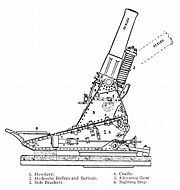 This gun was designed as a siege howitzer firing a special 122 pounds (55.33826914 kg) howitzer shell. It was designed to be fired from a static siege platform, with wheels removed, for accurate long-range shooting. When fired mounted on its normal wheeled travelling carriage, which had become standard practice for modern medium artillery, its range and accuracy diminished due to limited elevation and also lack of a modern recoil mechanism.
This gun was designed as a siege howitzer firing a special 122 pounds (55.33826914 kg) howitzer shell. It was designed to be fired from a static siege platform, with wheels removed, for accurate long-range shooting. When fired mounted on its normal wheeled travelling carriage, which had become standard practice for modern medium artillery, its range and accuracy diminished due to limited elevation and also lack of a modern recoil mechanism.
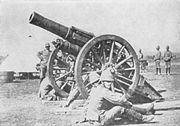 12 Guns were employed in South Africa in the Second Boer War
12 Guns were employed in South Africa in the Second Boer War
as part of the British siege train. It was during this campaign that the short range limitation became evident, and shell weight was traded for greater range in 1901 with the introduction of a "light" 100 pounds (45.4 kg) shell which increased maximum range when firing from its wheeled travelling carriage to 7000 yards. No use was found for the siege platform which allowed elevation to 70° : "This capability was designed for distinct siege operation, and in South Africa the need for this did not arise. In this theatre the platform was an encumbrance, and it was discovered that it could be dispensed with".
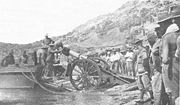 When World War I began approximately 80 guns were still available. They constituted the only true heavy artillery the British army possessed, and were heavily engaged in the early battles in France and Flanders. It was adapted to use the standard 100 pounds (45.4 kg) gun shell, with a slight enlargement of the chamber to produce Mk I*, allowing slightly larger propellant charges. It served in all theatres, including the Western Front, until replaced by the modern 6 inch 26 cwt howitzer from late 1915. However, Gallipoli
When World War I began approximately 80 guns were still available. They constituted the only true heavy artillery the British army possessed, and were heavily engaged in the early battles in France and Flanders. It was adapted to use the standard 100 pounds (45.4 kg) gun shell, with a slight enlargement of the chamber to produce Mk I*, allowing slightly larger propellant charges. It served in all theatres, including the Western Front, until replaced by the modern 6 inch 26 cwt howitzer from late 1915. However, Gallipoli
was given low priority for modern ordnance and the 6 inch 30 cwt was used by 14th Siege Battery RGA (4 guns), attached to 29th Division, at Helles, and by the Australian 1st Heavy Artillery Battery
(2 guns from the Royal Malta Artillery, crewed by the Royal Marine Artillery, which arrived in May) at Anzac.
(amalgamated in 1924 into Royal Artillery
United Kingdom
The United Kingdom of Great Britain and Northern IrelandIn the United Kingdom and Dependencies, other languages have been officially recognised as legitimate autochthonous languages under the European Charter for Regional or Minority Languages...
medium howitzer
Howitzer
A howitzer is a type of artillery piece characterized by a relatively short barrel and the use of comparatively small propellant charges to propel projectiles at relatively high trajectories, with a steep angle of descent...
used in the Second Boer War
Second Boer War
The Second Boer War was fought from 11 October 1899 until 31 May 1902 between the British Empire and the Afrikaans-speaking Dutch settlers of two independent Boer republics, the South African Republic and the Orange Free State...
and early in World War I
World War I
World War I , which was predominantly called the World War or the Great War from its occurrence until 1939, and the First World War or World War I thereafter, was a major war centred in Europe that began on 28 July 1914 and lasted until 11 November 1918...
. The qualifier "30cwt" refers to the weight of the barrel and breech together which weighed 30 hundredweight
Hundredweight
The hundredweight or centum weight is a unit of mass defined in terms of the pound . The definition used in Britain differs from that used in North America. The two are distinguished by the terms long hundredweight and short hundredweight:* The long hundredweight is defined as 112 lb, which...
(cwt) : 30 x 112 lb = 3360 lb. It can be identified by the slightly flared shape of the muzzle and large recuperator springs below the barrel.
History
Introduced 1896, based on an Indian Army design.Its original shell was 122 lb 9 oz Lyddite explosive. In 1901 a lighter 100 lb (45.4 kg) shell was introduced which increased maximum range when firing from its wheeled travelling carriage to 7000 yards. These were then referred to as the "heavy" and "light" shell respectively. A 100 lb shrapnel shell was also available.
It was phased out and replaced by 6 inch 26 cwt howitzer from late 1915 onwards.
Combat use

Second Boer War

Second Boer War
The Second Boer War was fought from 11 October 1899 until 31 May 1902 between the British Empire and the Afrikaans-speaking Dutch settlers of two independent Boer republics, the South African Republic and the Orange Free State...
as part of the British siege train. It was during this campaign that the short range limitation became evident, and shell weight was traded for greater range in 1901 with the introduction of a "light" 100 pounds (45.4 kg) shell which increased maximum range when firing from its wheeled travelling carriage to 7000 yards. No use was found for the siege platform which allowed elevation to 70° : "This capability was designed for distinct siege operation, and in South Africa the need for this did not arise. In this theatre the platform was an encumbrance, and it was discovered that it could be dispensed with".
World War I

Battle of Gallipoli
The Gallipoli Campaign, also known as the Dardanelles Campaign or the Battle of Gallipoli, took place at the peninsula of Gallipoli in the Ottoman Empire between 25 April 1915 and 9 January 1916, during the First World War...
was given low priority for modern ordnance and the 6 inch 30 cwt was used by 14th Siege Battery RGA (4 guns), attached to 29th Division, at Helles, and by the Australian 1st Heavy Artillery Battery
Australian 1st Heavy Artillery Battery
1st Heavy Artillery Battery was an Australian artillery unit during World War I. Formed at Gallipoli on 14 July 1915 the battery formed part of the 1st Division artillery. The battery was originally equipped with 2 old 6 inch 30 cwt howitzers and one even older 4.7 inch naval gun. The battery was...
(2 guns from the Royal Malta Artillery, crewed by the Royal Marine Artillery, which arrived in May) at Anzac.
Greco-Turkish War (1919–1922)
Judging by official Greek photograhs and text, at least one howitzer was deployed by Greece during the Greco-Turkish War of 1919 – 1922.World War I ammunition
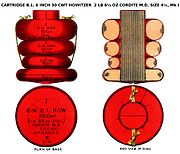 |
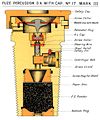 |
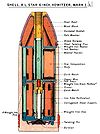 |
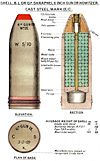 |
 |
 |
|
One or more rings were removed for shorter ranges. |
Operators
- 2 pieces, 1st Heavy Artillery Battery (see Ross Mallett, AIF 1914-1918 Artillery & 2. Gallipoli) - Royal Garrison ArtilleryRoyal Garrison Artillery
The Royal Garrison Artillery was an arm of the Royal Artillery that was originally tasked with manning the guns of the British Empire's forts and fortresses, including coastal artillery batteries, the heavy gun batteries attached to each infantry division, and the guns of the siege...
(amalgamated in 1924 into Royal Artillery
Royal Artillery
The Royal Regiment of Artillery, commonly referred to as the Royal Artillery , is the artillery arm of the British Army. Despite its name, it comprises a number of regiments.-History:...
See also
- 15 cm sFH 0215 cm sFH 02The 15 cm schwere Feldhaubitze 1902 was a German heavy field howitzer introduced in 1903 and served in World War I.-Design and history:It was the first artillery piece to use a modern recoil system in the German Army. Some 416 were in service at the beginning of the war...
: German equivalent - 6 inch 26 cwt howitzer : British Empire successor
- List of howitzers
Surviving examples
- A gun at Royal Artillery Museum, Woolwich, London
- A gun at the War Museum of Athens
- A gun at the Imperial War Museum, Duxford, UK

